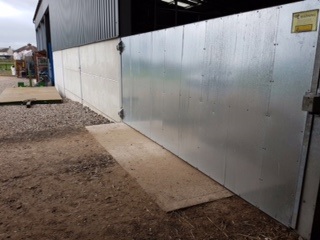Paul Brereton along with his son, runs a beef suckler farm in Market Drayton on the Shropshire-Staffordshire border within the High Risk Area (HRA). Initially the land was purchased in 2006, and prior to this it was used to grow cereal crops. In 2010, Paul decided to diversify into beef farming and initially purchased around 12 cattle, all of which were Limousine-cross heifers from a farm based in Audlem in Cheshire. As they were his initial stock, he was especially careful to check their TB history and post-movement TB tested them after they arrived on his farm.
In 2012, the Brereton family then purchased pedigree Blonde d’Aquitaine cattle from a breeder which was a closed herd that had never had an outbreak of TB recorded on the farm. At present, the herd size is 40 comprising of 30 cows and heifers and 10 bulls and steers. Fred, the main stock bull, is bred with the suckler cows. Most of the fattening stock are usually kept for two years and then sold at market. Since the purchase of the last cow 18 months ago, the herd has remained a closed herd. In terms of surroundings, next to the 6.9 hectare farm there is a disused railway line and shrub land where badgers reside. Directly adjacent to Paul’s farm there are several fields of maize crop, a crop which attracts badgers.
To help prevent badgers visiting his farm, Paul has built a fence comprising of two layers of 2m high tensile wire as well as poles treated with creosote to ensure the fence is long lasting. Although treated poles are three times the price of normal posts, they are guaranteed to last up to 25 years, which Paul considers a cost effective investment. It is unlikely that badgers can gain access to the farm by burrowing underneath the fence, as Paul has buried a further single strand of wire underneath the fence as well as planting a hedge to one side.
As Paul breeds Blonde d’Aquataine pedigree bulls, he does not like to take chances when it comes to his cattle contracting TB. He finds that being in the HRA means that reducing the risk of a TB breakdown is even more of a priority. Paul considers implementing biosecurity measures as a non-negotiable, crucial step to preventing breakdowns. He considers this a key aspect to running an effective efficient and sustainable business. For Paul, implementing preventative measures are key to ensuring the longevity of the farm:
“The consequences of a TB breakdown are just not worth it, both financially and emotionally. Although TB is a complex disease, there is a lot you can do to control it, whether that is checking the TB history of a farm you are purchasing cattle from, or ensuring all cattle feed is securely locked up preventing access by badgers. It’s worth prioritising. For me, it makes sense to invest time and money implementing as much biosecurity as possible because the financial loss from a TB breakdown is considerably more. Also breakdowns take up quite a lot of your time too, as you have to get all your cattle TB tested, so why not spend that time installing electrical fencing or locking up feed securely?”
Paul’s approach to biosecurity is innovative yet cost effective, for example using a canning stacking method to stack haylage bales. This method leaves little space between bales to allow anything to walk through.
Paul has specially adapted cattle troughs that are angled backwards at 55 degrees and wider than other troughs so that badgers cannot climb them to feed. The extra width also means that the feed is generally kept off the floor and Paul ensures that the floors are cleaned on a regular basis so as not to attract badgers.
Cattle feed is kept in a skip and covered with rubber sheeting. It also has slippery galvanized sides and is too high for badgers to climb. The cattle sheds are secured with a galvanized steel door and there are no gaps at the bottom or sides for badgers to access the area.
Storing his manure heap at least 100 metres away from the cattle sheds, as well as stirring it regularly, helps to reduce the chances of it harbouring the TB bacterium. It is also left for two years before it is spread onto any of the fields ensuring that any remaining bacteria in the heap is destroyed.
Moreover, Paul makes a conscious effort to be aware of the latest farming technology and biosecurity developments, an example being when he attended a TB biosecurity workshop run by XL Vets at Reaseheath College. These workshops advised farmers on simple biosecurity measures they could implement to help protect their herd against TB, through short presentations, group discussions and a practical farm walk.
Paul’s knowledge of biosecurity developments and farm technology proved particularly useful when an old foot stile on the farm broke. As some of the land on his farm serves as a public right of way, this would have been replaced by an equivalent stile by the local authority. Paul’s view is that old foot stiles can exacerbate the risk of spreading TB as they do not act as an effective barrier against wildlife entering the farm. To help alleviate this, Paul suggested the local authority could use a curved kissing gate made from galvanised steel. The closing nature of the gate ensures it is not left open by any members of the public. The local authority was extremely receptive to the idea. Both parties then worked together to ensure the gate was installed, with the local authority paying for the gate and Paul providing the labour.
Due to Paul’s thorough approach to biosecurity since establishing the farm, there has only been one TB reactor in 2012 which showed up on the annual TB test. However, since then the herd has remained TB free and the most recent annual test in March 2017 was clear.










